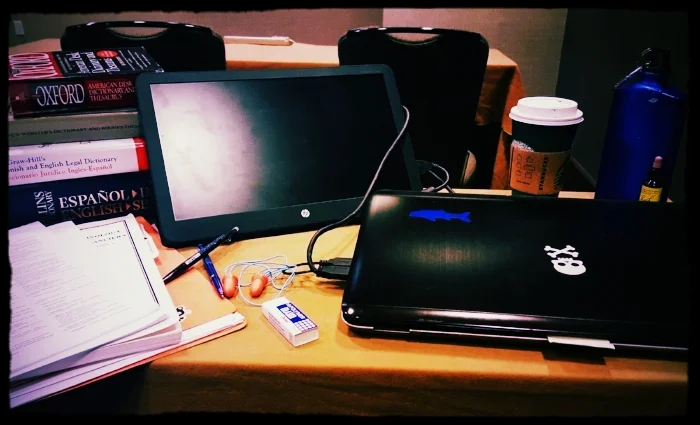How I Passed the ATA Certification Exam on the 1st Attempt
/Why Become a Certified Translator?
Passing the American Translators Association (ATA) certification exam with its daunting 15% pass rate is nothing to shake a stick at and preparing for it should not be taken lightly. Along the same lines, many countries offer rigorous programs and testing to become “sworn translators,” such as Spain and Brazil, though the ATA exam does not preclude candidates based on nationality. In the United States, there is no such thing as a government-approved “sworn translator”. Translation isn’t an industry that’s regulated by the government in the US. You don’t have to pass any boards or bars to deem yourself a translator.
In some ways, not being regulated by the government is both good and bad. The good part is, for clients, the market is very competitive. It’s also good for professionals because you can get relevant experience and build a fruitful career without having your hopes and dreams dashed by test anxiety or suffocating student loans. Overall, it’s less bureaucratic.
The downside for clients is having to sift through the numerous providers, possibilities, and uncertainties for translation services: Do I hire a professional? Can my bilingual employee or friend do this for me? What if I need a certified translation? The answer to all of those questions is that it depends. There have been many other articles devoted to this topic and an exceptional publication about it is available on the ATA website here.
This is where the ATA steps in, to “allow translators to demonstrate that they meet certain standards of the translation profession” and somewhat fill the void of not having “sworn translators” in the United States. As the largest national association for translators in the US, the ATA offers a goal for translators to strive for. Being “ATA-certified” has clout. It’s not an easy exam to pass and most people don’t do so on the first attempt. It provides proof of a translator’s competency in a given language pair.
Exam Components
The exam itself consists of two passages, each about 250 words. Traditionally, candidates would write out their translations for the exam passages by hand, only using paper dictionaries and resources. However, as the entire industry has shifted into the digital world, ATA has recognized the fact that professional translators use technology and online resources to produce their work. Thus beginning in 2015 they have started offering the exam in a computerized format, with limited internet access, bandwidth permitting. A list of the permitted websites to access during the is available here. In essence, you can access online dictionaries, including Word Reference, Linguee, Oxford and Merriam-Webster. However, you cannot access dictionaries or sites that include Q&A forums such as Proz or the Word Reference forums.
Practice Exam
My quest to pass the ATA exam began in January 2016. I ordered a practice test, which is a previous year’s exam to do at home and have it evaluated by an actual ATA exam grader. I tried to emulate the exam conditions as much as possible by limiting myself to 3 hours, completing the translations by hand and only using paper dictionaries. On one passage I passed, and the other one I failed by 3 points. I lost a point for a comma. Another for putting “with respects to” instead of “with respect to.” Small mistakes that amounted to a big loss. My colleague Juan Lizama wrote about this phenomenon, based on presentations, interviews and study groups where ATA exam graders gave their feedback, in his article “Death by A Thousand Cuts” on the OSTI blog.
Study Group
In March 2016 I joined a group of fellow translators to form a study group, through the Oregon Society of Translators and Interpreters (OSTI). The study group was led by the then-OSTI president, Helen Eby. Every week a group of 6-16 Spanish-English (and some French) translators would complete a sample passage, review a colleague’s translation and meet online for discussion. In addition to practicing translation, we also had the honor of having presentations by actual ATA exam graders, Anne Louise, Holly Mikkelson and Paul Coltrin. The generously gave their insights as to how the exams are graded and common tripwires. Below are some nuggets of wisdom I’ve gleaned from all of this preparation.
Study Resources
Bear in mind, most of these resources and tips are geared for Spanish-English translators. Others, like diagramming, can possibly work for any language pair. Anne Louise recommended diagramming to break down long, convoluted sentences. A fantastic tool to help break down English sentences is the Fox Type Sentence Tree available here. If anyone knows of a similar tool for Spanish or Portuguese, please let me know!
Another valuable pointer from the graders is to be mindful of collocations. This is an area where sticking to the literal translation will burn you. A great collocation resource to see which words go together best is available by Oxford here.
Some language-specific tips are that Spanish loves nouns and English loves verbs. See where words ending in “-ción" can be translated to end in “-ing” for a more natural flow. Many times reflexive verbs in Spanish translate best to the passive tense in English. I’m not a big fan of the passive tense, but sometimes there really isn’t a better option.
Tips for the Exam:
Trust your gut and original instinct. When going back over the translated text, don’t change things unless they’re really needed, such as misspellings and grammar errors.
If you make the same mistake more than once, you’ll only get docked once. For example, if you erroneously translate a term the wrong way, and that term appears several times in the text, you’ll only be discounted points for the first occasion.
Take a break, go to the bathroom and do some stretches after finishing the first draft. I did some yoga in the hallway before going back in to edit and proofread my exam passages.
Don’t rely on internet resources being available for the computerized exam, due to limited bandwidth or technology issues. Bring paper dictionaries and resources and be prepared to complete the exam by hand should technical difficulties arise.
For the handwritten exam, don’t write out a first draft and then a second draft. You’ll lose a lot of precious time that could be spent revising and proofreading. You can use standard proofreading marks to insert or delete text as needed. Just make sure it’s legible.
I took the computerized exam and would highly recommend that for translators, if possible. Aside from the obvious reasons of being able to easily edit and rearrange your sentences, it will leave your hands less fatigued than handwriting everything. However, not all exam sittings offer computerized versions and technology is known to fail, so be prepared to write it out if needed.
What to bring:
· Computer, with the websites you want to access pre-loaded on your browser
· Word Pad app, up and running. No spell-check or grammar correction allowed. If the moderators see the red squiggly lines under words or passages, you will be disqualified.
· Unabridged bilingual dictionary
· English (target) monolingual dictionary and thesaurus
· Spanish (source) monolingual dictionary
· Specialized dictionaries (I printed the PDF versions of some legal and business glossaries, and had a PDF of Black’s Law dictionary available on screen)
· Erasable gel pens (recommended for handwritten exams. Your hand doesn’t have to press down so hard and thus doesn’t fatigue as easily)
· Erasers
· Highlighter
· Scratch paper
· Earplugs
· Rescue Remedy
· Water
· Coffee
· Good luck charms
Certified!
After all of these months of preparation and review, travelling 1000 miles to take the exam while 7 months pregnant, and finishing it with just 30 seconds to spare, I’m happy to report that I passed the exam on my first attempt and am now officially a certified translator for Spanish to English translations! Along with certification comes continuing education requirements so my inner nerd delights at having to profundizar in the subject. Next up I’m planning to prepare for and take the Portuguese to English exam. If anyone wants to study with me or has any questions on the exam experience, please reach out or leave a comment!
Resources
Guide to ATA Certification Program
http://atanet.org/certification/aboutcert_overview.php
Traductores/as – Intérpretes Jurados/as
Tradução Juramentada
http://www.atpiesp.org.br/associacao/traducao-juramentada/
Translation: Getting it Right
https://www.atanet.org/publications/getting_it_right.php
Practice Test for the ATA Certification Exam
http://atanet.org/certification/aboutpractice_test_instructions.php
Death by a Thousand Cuts
http://ostiweb.org/death-by-a-thousand-cuts/
ATA Study Program – week 1
http://ostiweb.org/ata-study-program-week-1/
Oregon Society of Translators and Interpreters
How to Diagram a Sentence
http://www.huffingtonpost.com/2014/10/01/diagram-sentence-grammar_n_5908462.html
Fox Type Sentence Tree
https://foxtype.com/sentence-tree
Online Collocation Dictionary
http://www.freecollocation.com/

